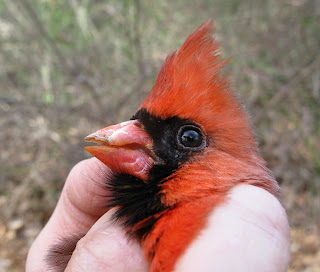It appears to be a good year for migrating chickadees.
We've had good numbers this month with many showing signs of fat, indicating they are taking off for greener pastures! None of our previously banded chickadees had any fat, but most of the new ones we banded early on had a good amount of fat. One of those, a second year bird (SY) also showed signs of leucism, which simply means a defect of some sort preventing the deposit of melanin in the feather. The back feathers on this chickadee aren't solid gray but a mixture of gray and white. I find this most often on younger birds, the bird below was born last year.
A chickadee captured on the 30th was 7 years old, we first banded her as a hatch year (HY) in 2006. We've captured her every year since then, mostly in the same area, 27 times total!
Our only Golden-crowned Kinglets captured were on the 14th, we could hear them all over the island that morning.
They were both females, with only yellow and no orange feathers visible in the crown.
Golden-crowned Kinglets spend the winter on Cape Cod, but prefer the boreal forests further north to breed, usually raising two broods.
Cardinals also dominated our morning of the 14th, all males.
This species can be difficult to age. Cardinals can do a complete molt during their first year, replacing all feathers just like the adults. Sometimes they skip over a few feathers allowing us to age them as SY at this time. The bird below did not replace secondaries 2, 3, or 7 (indicated by black arrows). They appear browner in the photo.
Another cardinal had something wrong with his beak on the upper mandible (possibly avian pox) and the end was breaking off. I did have a Pine Warbler once where we noted the tip had broken off and a year later it had grown back. We were able to see a line where the new growth started.
I had another cardinal with beak issues on the 29th, parts of the beak seemed to be peeling off.
White-throated Sparrows were captured on the 18th and 30th all brightly colored birds.
We also captured a bird we don't get very often on the 18th, a Brown Thrasher.
These birds belong to the Mimidae family, or family of mimics, along with catbirds and mockingbirds. They have a large repertoire of song, singing the same song twice, making them easy to distinguish between the other species. Unfortunately their numbers seem to be declining and our over abundance of catbirds seems to push them out of an otherwise attractive habitat for breeding. This up close photo shows the beautiful yellow eye.
She was aged as a SY due to the retention of juvenal primary coverts (no black barring).
The best bird of the month had to be the Worm-eating Warbler, which showed up on the 29th! This was only the 2nd to be banded at our site, the other appearing on April 25th, 2009.
Growth bars were evenly visible across the tail as well as across the wing indicating the feathers were grown in at once so the bird was aged SY.
Overall, numbers of birds this month were typical for April, maybe on the lower side and diversity was very low, but spring has never been great on Cape Cod. Let's hope we get some migrants in May! Thanks very much to all who helped out with banding (and net clearing) this month- Jo-Anna Ghadban, Keenan Yakola, Ben Lagasse, Alice and Jimmy Wynn, Gretchen Putonen, Carolyn Kennedy, and Judy Keller.
The following is a list of birds seen, heard, or banded during this time period.
Total birds: 88 Total species: 57
Total species of banded birds: 11 Birds/100 net-hours: 17
| Common Loon | |
| Double-crested Cormorant | |
| Great Blue Heron | |
| Snowy Egret | |
| Brant | |
| Canada Goose | |
| American Black Duck | |
| Mallard | |
| Blue-winged Teal | |
| Turkey Vulture | |
| Osprey | |
| Cooper's Hawk | |
| Greater Yellowlegs | |
| Willet | |
| Laughing Gull | |
| Ring-billed Gull | |
| Herring Gull | |
| Great Black-backed Gull | |
| Mourning Dove | |
| Belted Kingfisher | |
| Red-bellied Woodpecker | |
| Yellow-bellied Sapsucker | |
| Downy Woodpecker | |
| Hairy Woodpecker | |
| Yellow-shafted Flicker | |
| Eastern Phoebe | |
| Tree Swallow | |
| Barn Swallow | |
| Blue Jay | 1 RECAPTURE |
| American Crow | |
| Fish Crow | |
| Black-capped Chickadee | 18 NEW; 29 RECAPTURES; 2 UNBANDED |
| Tufted Titmouse | 2 NEW; 1 RECAPTURE |
| Red-breasted Nuthatch | |
| White-breasted Nuthatch | |
| Carolina Wren | 1 NEW |
| Golden-crowned Kinglet | 2 NEW |
| American Robin | |
| Northern Mockingbird | |
| Brown Thrasher | 1 NEW |
| European Starling | |
| Myrtle (Yellow-rumped) Warbler | |
| Pine Warbler | |
| Prairie Warbler | |
| Worm-eating Warbler | 1 NEW |
| Northern Cardinal | 4 NEW; 1 RECAPTURE; 1 UNBANDED |
| Eastern Towhee | |
| Chipping Sparrow | |
| Song Sparrow | 4 NEW; 11 RECAPTURES |
| White-throated Sparrow | 1 NEW; 1 RECAPTURE |
| Dark-eyed Junco | |
| Red-winged Blackbird | |
| Common Grackle | |
| Brown-headed Cowbird | |
| House Finch | |
| American Goldfinch | 7 NEW |
| House Sparrow | |


















